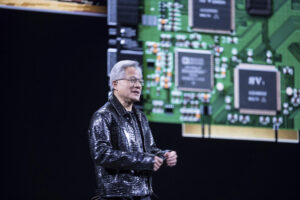Nvidia (NVDA) stock took a hit on Tuesday, plunging as much as 5% following a day of promise and expectation built around CEO Jensen Huang’s keynote at the prestigious 2025 CES trade show in Las Vegas. Anticipation was high after Nvidia reached a record close on Monday, but after a brief surge early in Tuesday’s trading—where shares rose as much as 2.5%—the stock saw a stark reversal.
The market turmoil wasn’t just about Nvidia. The broader stock market faced challenges as mixed data on November job openings emerged, alongside economic indicators igniting inflation concerns. Despite the recent pullback, Nvidia’s shares are still impressively up about 190% compared to last year. This bullish trajectory was bolstered by the updates shared at CES, which many analysts believe will enhance the company’s growth prospects.
Analyst Insights and Predictions
Despite the recent volatility, several prominent analysts have reiterated their Buy ratings on Nvidia. Institutions such as Stifel, Wedbush, and Truist Securities remain optimistic about Nvidia’s future, pointing to an average target price of $172.80 for the shares over the next year. Truist Securities’ analyst William Stein noted Nvidia’s strategic positioning across various sectors—from data centers to autonomous vehicles—underscoring their commitment to supporting revenue growth.
Cutting-Edge Innovations
One of the standout announcements from Huang’s keynote was the introduction of the GB10 superchip, a compact yet powerful artificial intelligence chip included in Nvidia’s new client supercomputer. This groundbreaking device is designed to fit comfortably on a desk, making advanced AI computing more accessible for developers, researchers, and students alike. Set to launch in May at a price point of $3,000, the GB10 superchip will certainly attract attention in the tech community.
In addition to the supercomputer, Nvidia unveiled its ambitious Cosmos platform for robotics, which provides AI models that facilitate the development of humanoid robots and autonomous vehicles. These innovations signal Nvidia’s expansive vision in robotics, an area that Wedbush analyst Dan Ives estimates could represent a staggering $1 trillion market. Huang himself projected that technologies surrounding autonomous driving could eventually lead to the first multitrillion-dollar industry in robotics.
Gaming and AI Futures
Nvidia also showcased new Blackwell-generation gaming GPUs, emphasizing its commitment to supporting developers in launching custom AI agents. There’s further speculation that Nvidia may unveil an upgraded generation of AI chips during its upcoming GTC conference in March, which could send ripples through the tech investment landscape.
Conclusion: Navigating the Stock and Tech Landscape
While Nvidia’s stock has seen some downturn, the underlying fundamentals suggest a company at the forefront of incredible technological advancements. The volatility surrounding economic data and market sentiments shouldn’t overshadow the noteworthy strides Nvidia is making in AI, robotics, and gaming technology. Investors would do well to keep a close watch on Nvidia, as both the innovations coming out of CES and the company’s strategic positioning highlight a bright future. By staying informed and aligned with these developments, investors can navigate the complexities of the tech market more adeptly.
With Extreme Investor Network, we’ll continue to bring you the insights and analyses that matter most, empowering your investment decisions in a fast-paced financial landscape.

